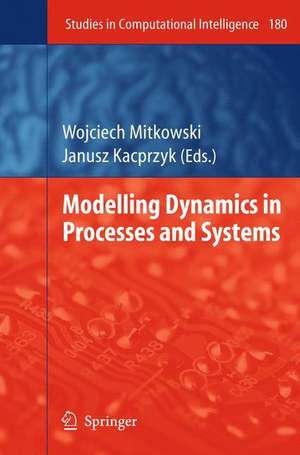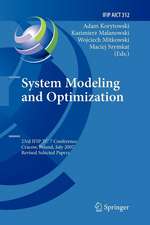Modelling Dynamics in Processes and Systems: Studies in Computational Intelligence, cartea 180
Editat de Wojciech Mitkowskien Limba Engleză Hardback – iun 2009
A convenient tool to deal with dynamics and its related evolution over time is to use the concept of a dynamic system which, for the purposes of this volume can be characterized by the input (control), state and output spaces, and a state transition equation. Then, starting from an initial state, we can find a sequence of consecutive states (outputs) under consecutive inputs (controls). That is, we obtain a trajectory. The state transition equation may be given in various forms, exemplified by differential and difference equations, linear or nonlinear, deterministic or stochastic, or even fuzzy (imprecisely specified), fully or partially known, etc. These features can give rise to various problems the analysts may encounter like numerical difficulties, instability, strange forms of behavior (e.g. chaotic), etc.
This volume is concerned with some modern tools and techniques which can be useful for the modeling of dynamics. We focus our attention on two important areas which play a key role nowadays, namely automation and robotics, and biological systems. We also add some new applications which can greatly benefit from the availability of effective and efficient tools for modeling dynamics, exemplified by some applications in security systems.
| Toate formatele și edițiile | Preț | Express |
|---|---|---|
| Paperback (1) | 635.80 lei 6-8 săpt. | |
| Springer Berlin, Heidelberg – 28 oct 2010 | 635.80 lei 6-8 săpt. | |
| Hardback (1) | 642.03 lei 6-8 săpt. | |
| Springer Berlin, Heidelberg – iun 2009 | 642.03 lei 6-8 săpt. |
Din seria Studies in Computational Intelligence
- 20%
 Preț: 449.37 lei
Preț: 449.37 lei - 20%
 Preț: 1158.26 lei
Preț: 1158.26 lei - 20%
 Preț: 986.66 lei
Preț: 986.66 lei - 20%
 Preț: 1452.76 lei
Preț: 1452.76 lei - 20%
 Preț: 168.78 lei
Preț: 168.78 lei - 20%
 Preț: 1291.10 lei
Preț: 1291.10 lei - 18%
 Preț: 1112.30 lei
Preț: 1112.30 lei - 20%
 Preț: 565.39 lei
Preț: 565.39 lei - 20%
 Preț: 649.28 lei
Preț: 649.28 lei - 20%
 Preț: 1047.73 lei
Preț: 1047.73 lei - 20%
 Preț: 1578.96 lei
Preț: 1578.96 lei - 20%
 Preț: 643.50 lei
Preț: 643.50 lei - 20%
 Preț: 657.49 lei
Preț: 657.49 lei - 20%
 Preț: 993.28 lei
Preț: 993.28 lei - 20%
 Preț: 990.80 lei
Preț: 990.80 lei - 20%
 Preț: 989.96 lei
Preț: 989.96 lei - 20%
 Preț: 1165.69 lei
Preț: 1165.69 lei - 20%
 Preț: 1444.52 lei
Preț: 1444.52 lei - 20%
 Preț: 1041.96 lei
Preț: 1041.96 lei - 20%
 Preț: 1047.73 lei
Preț: 1047.73 lei - 20%
 Preț: 1046.06 lei
Preț: 1046.06 lei - 18%
 Preț: 2500.50 lei
Preț: 2500.50 lei - 20%
 Preț: 989.13 lei
Preț: 989.13 lei - 20%
 Preț: 1165.69 lei
Preț: 1165.69 lei - 20%
 Preț: 1164.05 lei
Preț: 1164.05 lei - 20%
 Preț: 1042.79 lei
Preț: 1042.79 lei - 20%
 Preț: 1460.19 lei
Preț: 1460.19 lei - 18%
 Preț: 1403.52 lei
Preț: 1403.52 lei - 18%
 Preț: 1124.92 lei
Preț: 1124.92 lei - 20%
 Preț: 1039.47 lei
Preț: 1039.47 lei - 20%
 Preț: 1008.11 lei
Preț: 1008.11 lei - 20%
 Preț: 1045.25 lei
Preț: 1045.25 lei - 20%
 Preț: 1275.42 lei
Preț: 1275.42 lei - 20%
 Preț: 1040.32 lei
Preț: 1040.32 lei - 20%
 Preț: 988.32 lei
Preț: 988.32 lei - 20%
 Preț: 1169.79 lei
Preț: 1169.79 lei - 20%
 Preț: 1162.37 lei
Preț: 1162.37 lei - 20%
 Preț: 1059.26 lei
Preț: 1059.26 lei - 20%
 Preț: 1164.05 lei
Preț: 1164.05 lei - 20%
 Preț: 1166.52 lei
Preț: 1166.52 lei - 20%
 Preț: 1459.38 lei
Preț: 1459.38 lei - 18%
 Preț: 1005.74 lei
Preț: 1005.74 lei - 20%
 Preț: 997.38 lei
Preț: 997.38 lei - 20%
 Preț: 1055.94 lei
Preț: 1055.94 lei - 20%
 Preț: 1284.47 lei
Preț: 1284.47 lei - 20%
 Preț: 994.08 lei
Preț: 994.08 lei - 20%
 Preț: 1048.72 lei
Preț: 1048.72 lei - 20%
 Preț: 1066.02 lei
Preț: 1066.02 lei - 20%
 Preț: 943.78 lei
Preț: 943.78 lei - 20%
 Preț: 1173.10 lei
Preț: 1173.10 lei
Preț: 642.03 lei
Preț vechi: 755.33 lei
-15% Nou
Puncte Express: 963
Preț estimativ în valută:
122.87€ • 133.42$ • 103.21£
122.87€ • 133.42$ • 103.21£
Carte tipărită la comandă
Livrare economică 23 aprilie-07 mai
Preluare comenzi: 021 569.72.76
Specificații
ISBN-13: 9783540922025
ISBN-10: 3540922024
Pagini: 204
Ilustrații: XII, 192 p.
Dimensiuni: 155 x 235 x 22 mm
Greutate: 0.46 kg
Ediția:2009
Editura: Springer Berlin, Heidelberg
Colecția Springer
Seria Studies in Computational Intelligence
Locul publicării:Berlin, Heidelberg, Germany
ISBN-10: 3540922024
Pagini: 204
Ilustrații: XII, 192 p.
Dimensiuni: 155 x 235 x 22 mm
Greutate: 0.46 kg
Ediția:2009
Editura: Springer Berlin, Heidelberg
Colecția Springer
Seria Studies in Computational Intelligence
Locul publicării:Berlin, Heidelberg, Germany
Public țintă
ResearchCuprins
Basic Tools and Techniques for the Modelling of Dynamics.- Modeling of Chaotic Systems in the ChaoPhS Program.- Model of a Tribological Sensor Contacting Rotating Disc.- The Bifurcations and Chaotic Oscillations in Electric Circuits with Arc.- Modelling Dynamics in Control and Robotics.- Soft Computing Models for Intelligent Control of Non-linear Dynamical Systems.- Model Reference Adaptive Control of Underwater Robot in Spatial Motion.- Feedback Stabilization of Distributed Parameter Gyroscopic Systems.- Stabilization Results of Second-Order Systems with Delayed Positive Feedback.- Modelling Dynamics in Biological Processes.- A Comparison of Modeling Approaches for the Spread of Prion Diseases in the Brain.- Ensemble Modeling for Bio-medical Applications.- New Application Areas.- Automatic Fingerprint Identification Based on Minutiae Points.- Image Filtering Using the Dynamic Particles Method.- The Simulation of Cyclic Thermal Swing Adsorption (TSA) Process.- The Stress Field Induced Diffusion.
Textul de pe ultima copertă
Dynamics is what characterizes virtually all phenomenae we face in the real world, and processes that proceed in practically all kinds of inanimate and animate systems, notably social systems. For our purposes dynamics is viewed as time evolution of some characteristic features of the phenomenae or processes under consideration. It is obvious that in virtually all non-trivial problems dynamics can not be neglected, and should be taken into account in the analyses to, first, get insight into the problem consider, and second, to be able to obtain meaningful results.
A convenient tool to deal with dynamics and its related evolution over time is to use the concept of a dynamic system which, for the purposes of this volume can be characterized by the input (control), state and output spaces, and a state transition equation. Then, starting from an initial state, we can find a sequence of consecutive states (outputs) under consecutive inputs (controls). That is, we obtain a trajectory. The state transition equation may be given in various forms, exemplified by differential and difference equations, linear or nonlinear, deterministic or stochastic, or even fuzzy (imprecisely specified), fully or partially known, etc. These features can give rise to various problems the analysts may encounter like numerical difficulties, instability, strange forms of behavior (e.g. chaotic), etc.
This volume is concerned with some modern tools and techniques which can be useful for the modeling of dynamics. We focus our attention on two important areas which play a key role nowadays, namely automation and robotics, and biological systems. We also add some new applications which can greatly benefit from the availability of effective and efficient tools for modeling dynamics, exemplified by some applications in security systems.
A convenient tool to deal with dynamics and its related evolution over time is to use the concept of a dynamic system which, for the purposes of this volume can be characterized by the input (control), state and output spaces, and a state transition equation. Then, starting from an initial state, we can find a sequence of consecutive states (outputs) under consecutive inputs (controls). That is, we obtain a trajectory. The state transition equation may be given in various forms, exemplified by differential and difference equations, linear or nonlinear, deterministic or stochastic, or even fuzzy (imprecisely specified), fully or partially known, etc. These features can give rise to various problems the analysts may encounter like numerical difficulties, instability, strange forms of behavior (e.g. chaotic), etc.
This volume is concerned with some modern tools and techniques which can be useful for the modeling of dynamics. We focus our attention on two important areas which play a key role nowadays, namely automation and robotics, and biological systems. We also add some new applications which can greatly benefit from the availability of effective and efficient tools for modeling dynamics, exemplified by some applications in security systems.
Caracteristici
Latest research on modelling dynamics in processes and systems
















